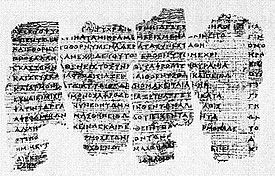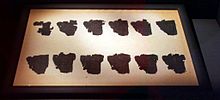- Derveni papyrus
-
The Derveni papyrus is an ancient Greek papyrus roll that was found in 1962. It is a philosophical treatise that is an allegorical commentary on an Orphic poem, a theogony concerning the birth of the gods, produced in the circle of the philosopher Anaxagoras in the second half of the 5th century BC, making it "the most important new piece of evidence about Greek philosophy and religion to come to light since the Renaissance" (Janko 2005). It dates to around 340 BC, during the reign of Philip II of Macedon, making it Europe's oldest surviving manuscript.[1][2] It was finally published in 2006.
Contents
Discovery
The roll was found at a site in Derveni, Macedonia, northern Greece, in a nobleman's grave in a necropolis that was part of a rich cemetery belonging to the ancient city of Lete. It is the oldest surviving manuscript in the Western tradition and one of very few surviving papyri found in Greece.[1] The roll is carbonized from the pyre of the nobleman's grave. The papyrus is kept in the Archaeological Museum of Thessaloniki.
Content
The text is a commentary on a hexameter poem ascribed to Orpheus. Fragments of the poem are quoted. The poem begins with the words "Close the doors, you uninitiated", a famous admonition to secrecy, recounted by Plato. The theogony described in the poem has Nyx (Night) give birth to Heaven (Uranus), who becomes the first king. Cronus follows and takes the kingship from Uranus, but he is likewise succeeded by Zeus.
Zeus, having "heard oracles from his father", goes to the sanctuary of Night, who tells him "all the oracles which afterwards he was to put into effect." Upon hearing them, Zeus "swallowed the phallus [of the king Uranus] who first had ejaculated the brilliance of heaven."[3]
Recent reading
The text was not officially published for forty-four years after its discovery (though three partial editions were published). A team of experts was assembled in autumn 2005 led by A. L. Pierris of the Institute for Philosophical studies and Dirk Obbink, director of the Oxyrhynchus papyrus project at the University of Oxford, with the help of modern multispectral imaging techniques by Roger Macfarlane and Gene Ware of Brigham Young University to attempt a better approach to the edition of a difficult text. Meanwhile, the papyrus has been published by scholars from Thessaloniki (Tsantsanoglou et al., below), which provides a complete text of the papyrus based on autopsy of the fragments, with photographs and translation. More work clearly remains to be done (see Janko 2006, below).
Style of writing
The text of the papyrus contains a mix of dialects. It is mainly a mixture of Attic and Ionic Greek, however it contains few Doric forms, which need further explanation. Sometimes the same word appears in different dialectal forms e.g cμικρό-, μικρό; ὄντα, ἐόντα; νιν for μιν etc [4].
Notes
- ^ a b "Ancient scroll may yield religious secrets". The Associated Press. http://www.msnbc.msn.com/id/13081639/. Retrieved 2006-06-01.
- ^ "THE PAPYRUS OF DERVENI". Hellenic Ministry of Culture. Archived from the original on 2006-04-28. http://web.archive.org/web/20060428200149/http://www.culture.gr/2/21/215/21505/215052/e21505206.html. Retrieved 2006-06-01.
- ^ Bowersock, G. W. Tangled Roots. From The New Republic Online 8 June 2005. Retrieved 6 June 2006.
- ^ For a full list, see Janko (1997) 62–3
Further reading
- Gábor Betegh, 2004. The Derveni Papyrus: Cosmology, Theology and Interpretation (Cambridge University Press). A preliminary reading, critical edition and translation. ISBN 0-521-80108-7. (books.google.)
- Richard Janko's Review of Betegh 2004
- Janko, Richard. “The Physicist as Hierophant: Aristophanes, Socrates and the Authorship of the Derveni Papyrus,” Zeitschrift fur Papyrologie und Epigraphik 118, 1997, pp. 61–94.
- Janko, Richard, “The Derveni Papyrus (Diagoras of Melos, Apopyrgizontes Logoi?): a New Translation,” Classical Philology 96, 2001, pp. 1–32 .
- Janko, Richard, “The Derveni Papyrus: An Interim Text,” Zeitschrift fur Papyrologie und Epigraphik 141, 2002, pp. 1–62.
- Laks, André, “Between Religion and Philosophy: The Function of Allegory in the Derveni Papyrus”, Phronesis 42, 1997, pp. 121–142.
- André Laks and Glenn W. Most, editors, 1997. Studies on the Derveni Papyrus (Oxford University Press).(books.google.)
- Most, Glenn W., “The Fire Next Time. Cosmology, Allegories, and Salvation in the Derveni Papyrus”, Journal of Hellenic Studies 117, 1997, pp. 117–135.
- K. Tsantsanoglou, G.M. Parássoglou, T. Kouremenos (editors), 2006. "The Derveni Papyrus" (Leo. S. Olschki Editore, Florence [series Studi e testi per il "Corpus dei papiri filosofici greci e latini, vol. 13]). ISBN 88-222-5567-4.
- Richard Janko's Review of Tsantsanoglou, Parássoglou, & Kouremenos 2006;Tsantsanoglou, Parássoglou, & Kouremenos' Response to Janko; Janko's Response.
Categories:- Greek manuscripts
- Ancient Greek works
- Greek religion texts
- Religion in ancient Macedonia
- Philip II of Macedon
- Greek language papyri
Wikimedia Foundation. 2010.


